Or, “How I Learned to (Mostly) Stop Worrying and Love the Electric Car”
It’s uncomfortably easy to hear people talking about the car you’re in when it’s nearly silent. As we pass through a downtown intersection, a young guy’s “oh my god it’s the electric Porsche” might as well have been uttered from the back seat.
That’s the effect the Porsche Taycan has in the wild. It demands attention, sucking the air out of the surrounding area faster than any turbo could. (Yeah yeah, this car is called Turbo and doesn’t actually feature any.) It doesn’t need to shout to do it either.
Spending a week with a Taycan Turbo was an eye-widening experience—and not just because of its startling standing starts with Launch Control. This four-door sports car—no, that’s not an exaggeration—is such a deeply desirable package that I found myself dreading handing back the keys at the end of our time together, more so than with anything else I’ve driven this year.
With the full review coming later this week, here’s what stood out in my personal notebook after seven days with the all-electric Porsche Taycan.
1. It’s wide. Like, really wide.
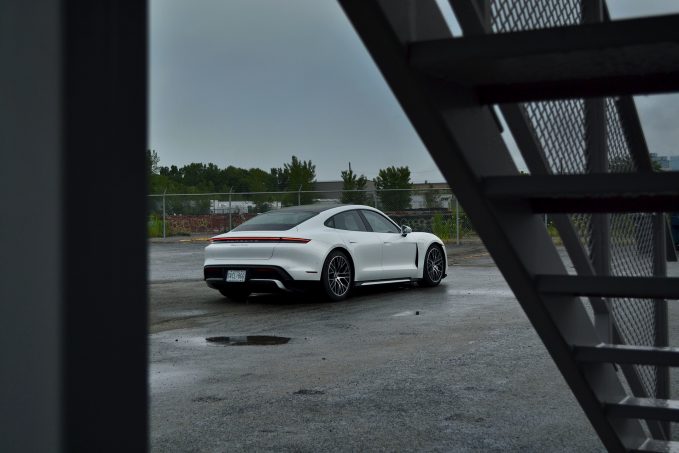
There aren’t many cars I’ve been happier to find a 360-degree camera in than the Taycan. From behind the wheel, the sight lines out ahead aren’t bad: the raised front corners feel instantly, classically Porsche, and make it easy to point the car forward. No, it’s the tiny rear window that eats away at confidence, and the feeling that the outer edges of the car are miles away. Parking in underground spots, like the one in my building, requires a spot bookended by pillars, lest you want to risk a pricey door ding. Going up the exit ramp isn’t really possible if a mid-size SUV is heading down the other direction.
Luckily, my tester came with the rear-wheel steering option, effectively shrinking the four-door’s turning circle at low speeds. When the speedo reads over 31 mph (50 km/h), those huge rear wheels steer in the same direction as the fronts, aiding stability.
SEE ALSO: 2020 Porsche Cayenne GTS Coupe First Drive Review: Pick of the Litter
2. Of course it’s fast, but you always feel in control
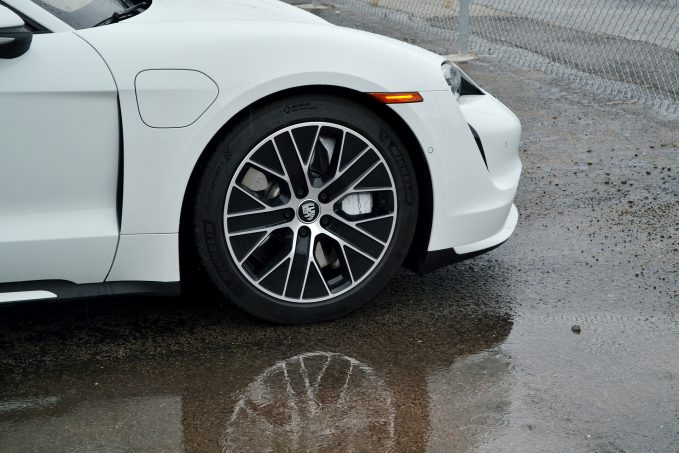
One of the common questions I get about this job is whether high-powered cars make me nervous. They certainly can—see above—but in the case of the Taycan, it’s not the power itself that does it. On the flip side, I’d say the Taycan’s power is a safety feature in ways, so long as it’s treated with the appropriate level of respect.
Simply put, this thing is silly fast. Pedal response is synapse-quick; I’d merely think about accelerating, and the Taycan would already be nudging up on the posted limit. Yet the go-pedal is fantastically progressive, making it easy to release exactly as many electric ponies as I needed. No highway on-ramp is too short for a Taycan Turbo; no passing opportunity too small.
The Taycan has a vast reserve of power available at all times, and the quick responses make the most of it. With much of the weight centered low down in the chassis, between the axles, it’s neutral and friendly, responding accurately to any driver inputs. It doesn’t completely mask its hefty curb weight, but the Taycan has a pointy, positive front-end that makes it feel like bigger, electron-munching 718 Cayman.
3. Range anxiety is still a thing (sort of)
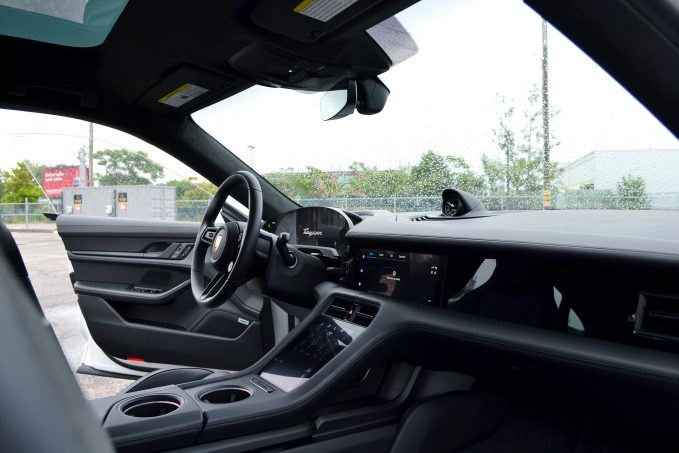
Hey look, it isn’t good news. While the Taycan outdid its low EPA quoted range of 201 miles—other outlets have seen the same results—my push to test that nearly resulted in an uncomfortable call to Porsche. Long story short: when I searched for an Electrify Canada fast-charger, I found one 28 miles (45 km) away, yet the Taycan was showing just 33.5 miles (54 km) left on its charge. Porsche Taycan owners get three years’ free charging from Electrify Canada/America, you see, and their fast-charger stations have begun to spring up around the Toronto area.
SEE ALSO: 2020 Chevrolet Bolt EV Review
Now this was my own fault, as I had just done a 45-minute stint on a highway, the sort of thing that drains batteries quicker. I also didn’t take advantage of the Taycan’s built-in ability to Nonetheless, it did make for a nerve-racking drive, especially when a flash downpour happened, the sort you can’t see more than 50 feet ahead in. When I got to the outlet mall, I first spotted a slow charger, with a Dodge Charger parked in front. I eventually found the Electrify Canada port, and plugged into a 150-kW outlet, since the 350-kW option was out of order. The Taycan gained back roughly 70 percent of its charge in a little over half an hour.
Admittedly, Porsche expects the majority of Taycan drivers to charge at home. I only ran low because . But with a lower quoted range than some other EVs out there, some folks will still question the ability of the Taycan to crush long distances without more frequent stops. You can’t exactly bring along a jerry can of electrons.
4. It looks (and sounds) like the future
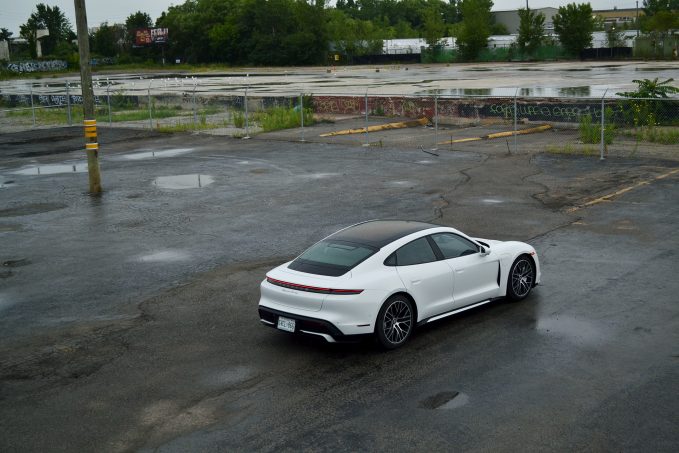
I’m lucky enough that this wasn’t my first time behind the wheel and curved glass instrument panel of a Taycan. I first saw it in 4S guise last December, on a first drive in the Finnish Arctic Circle. There, with a dozen or so examples, a handful of Cayennes and Panameras around, and traffic cars that I could count on a single hand, it was hard to judge the visual impact the Taycan wields. Transplant the shape to a busy metropolis and the result is the most gawking I’ve ever witnessed for a four-door.
SEE ALSO: 2020 Porsche Taycan 4S First Drive Review
Out in the wild, the Taycan makes anything this side of a BMW i8 look old-fashioned. Porsche’s design team has stayed remarkably loyal to the original Mission E design: the proportions are a little more modest, and the tail tapers more. There’s a clear family resemblance, but in a way that will surely dictate the next generation of Porsches, just as the 918 Spyder did years ago.
Every time I got into the Taycan, the first thing I’d do is enable the Electric Sport Sound. The amplified digital whirring is pure Jetsons, but there’s a good reason for its existence: humans have faster auditory reaction times than visual. As a cue for speed and acceleration, it’s key to getting the most out of the Taycan.
5. “It’s like a normal car.”
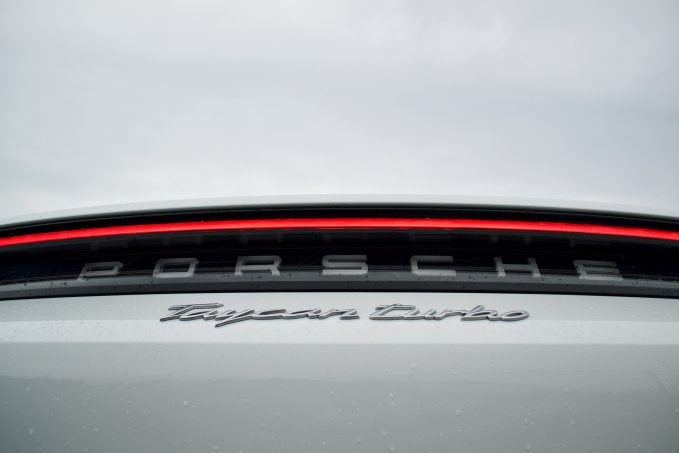
This is a direct quote from a friend, who I picked up—masked and sanitized, of course—for a short experience with the Taycan on our final day together. He first marvelled at the digital displays and effortless power, but it was only after prolonged exposure that he dropped that sub-header nugget.
When I asked what he meant, he explained that, from the passenger seat, the Taycan didn’t give off any fundamentally weird vibes compared to a run-of-the-mill luxury four-door. It rode well—more edge than a BMW 7 Series or some similar machine, but nothing uncouth—and the seats were comfortable. It built speed like a wave, imposing its will on the road ahead. The only real tell that we were in anything unusual is the distinct lack of noise to go with the accelerative effort. The Taycan can play the mobile oasis of calm just as well as the outsized sports car.
It’s a comforting sign, that. I love a good internal combustion engine as much as the next enthusiast, but the Taycan shows there can still be driving enjoyment even without the dino juice. It’s invigorating when it—and you—want it to be, and sacrifices little of what’s made cars so fascinating for drivers. Just maybe let it keep an eye on your nearby charging stations, yeah?
…



Leave a Reply